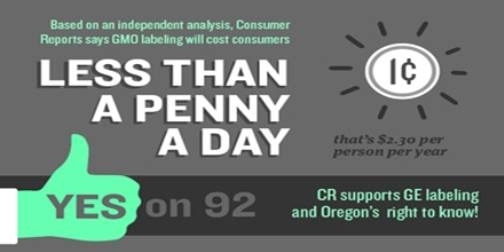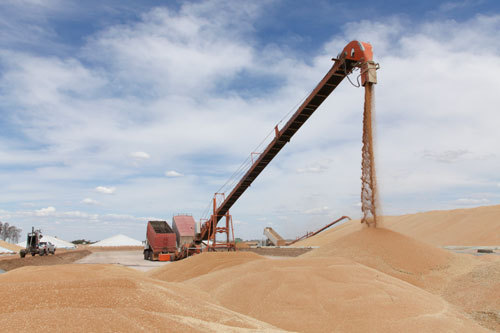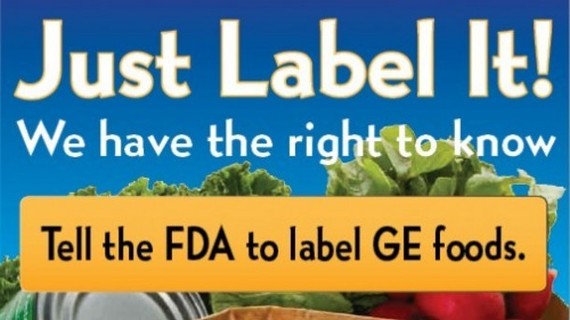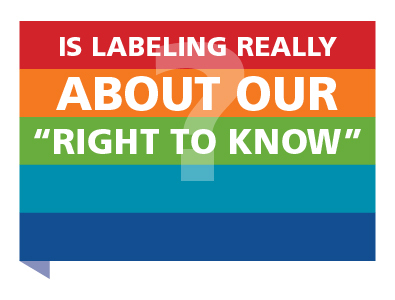Co-authored by Bruce Chassy and Jon Entine
This is Part II of a III part series. Part I: "Although Some GMO Sympathizers Embrace Mandatory Labeling, It's A Disaster In Waiting", is readable here.
"Because there is so much fear and so many misconceptions about genetically engineered food ... I'd ask [Ron Stotish, CEO of AquaBounty] to suck it up and put the label on it," wrote Tamar Haspel for the Washington Postin November after a GMO salmon was given a green light by the Food and Drug Administration.
The public wants it, she wrote, ignoring the hidden issue of costs. In effect she accepts at face value the statements of GMO opponents that labeling is little more than the cost of printing up labels. For example, Consumers Union, a long-time critique of crop and animal biotechnology, has claimed that a study it sponsored concluded that the "median cost of labeling genetically modified ingredients on grocery products would equate to an additional $2.30 per consumer each year." 
Don't believe it. The CU study measured only the costs of repackaging and new in-store promotional placards. But that's not where the costs are found. The cost is hidden in what it costs to determine what to print on the label!
Some of the costs incurred by enacting mandatory labeling can be known a priori. The costs apply independent of whether a company is producing GM or non-GM products. We will in fact argue that the cost will be higher for companies to choose to produce GMO-free products that do not require a label than it will be for those that choose to label.
The increased costs apply to all foods and ingredients moving through the system once labeling is mandatory. When such laws are passed, all the players in the entire food system must decide if they will be GMO-free or if they will produce products that will ultimately find their way to shelves bearing a mandatory GMO label. As we explain below, they would have to create separate handling and processing facilities, cope with increased cost of ingredients, formulate new products, fight for scarce space on supermarket shelves, and hope that they have made the right choices so they will be able to sell their products to a confused and skeptical public.
Do GMO crops provide cost and sustainability benefits?
Let's look at costs that would accrue regardless of what decisions all the other players' make. They fall into two broad categories: increased cost of ingredients and increased costs of segregation and testing.
A major benefit of the use of GMOs in agriculture is that farmers produce more at lower cost when they plant GM crops. A meta-analysis of the research literature concludes that GM crops increase farmers' yields significantly, on average by more than 20%, and lower labor and input costs, including the use of pesticides.
In November, the Department of Agriculture released its survey of 370 crops, concluding that some GM crops, like corn and soybeans, yielded as much as 35% more than comparable organic crops. This is one key reason why farmers are willing to pay a premium for GM seeds.
A shift away from GM crops to satisfy increased demand for non-GMO ingredients would have both direct and indirect effects. The lower productivity and higher cost of production would translate into a 10-50% increased cost of ingredients. Farmers and processors are already paid a price premium for GM free grain and ingredients, which is one reason why foods labeled GM-free are significantly more costly than their unlabeled and presumably GM-containing counterparts.
The indirect effects would be even greater. The study cited above documents that more land would need to be farmed, more pesticides would be used and agriculture would have greater environmental impact since the planting of GM crops lowers greenhouse gas emissions, and promotes water and soil conservation. If GM crops were removed from the marketplace, we would lose the production and environmental benefits of GM crops.
The economic benefits of GM crops don't accrue just to farmers. Higher productivity reduces the cost of animal feed and food ingredients which in turn benefits consumers. Any shift to non-GM varieties by farmers in order to meet demand for non-GM ingredients will tighten supplies and drive up prices for both GM and non-GM whole grain and ingredients made from them. Food companies will either absorb the cost increases--which is not likely--or pass it on to all consumers, not just those who select GM-free foods.
Labeling costs
It's also worth pointing out that the cost of the state labeling laws in Maine and Vermont, and the others being proposed at the state level, would not only (perhaps even not primarily) be born by producers who knowingly use GM ingredients. After all, if you're using commodity corn or soy, you can be pretty sure you've got GM ingredients in the mix. However, if you're a producer who wants to sell your product as "GM-free"--or even if you don't care about promoting your product as GM-free but think you're not using GM ingredients--the burden still falls on you to get written certifications and appropriate documentation of testing from your suppliers that your ingredients do not contain GM.
The biggest cost burden of mandatory GM labeling falls on those who wouldn't label their products as containing GM. Perhaps this is why the organic industry sponsors of GMO labeling legislation always make sure that the laws exempt organic products from labeling requirements beyond the organic certification process.
Segregation of a GM crop from a non-GM crop adds considerably to the cost of food. Separate facilities would be required to be built from farm to the supermarket to accomplish that end. Separation of GM from non-GM would be particularly difficult on the farm level since GM seeds and grain are indistinguishable from non-GM ones. Farmers would need to duplicate bins, tractors, implements, planters, storage facilities and so on to be able to separate the two products--and they would need costly tests to ensure they have done it right.
Research that shows facilities for separate handling would be needed to meet a 1 percent threshold of GMO in a non-labeled product. Most state initiatives have proposed even lower trigger thresholds for labeling. Setting a more liberal level of 5 percent mixing of GM with non-GM makes possible using the same facilities, however, no state bill has proposed this more reasonable a level. Is this because the real objective of mandatory labeling laws is to drive GMOs out of the marketplace?
Producers who want to avoid GM have to pay significant costs in order to avoid liability for unintentional presence of GE ingredients. If you're a grocery retailer that sells unlabeled foodstuffs, and someone 'finds' GM content in that food, you're on the hook for massive fines, penalties and perhaps lawsuits from disgruntled consumers who were actively trying to buy GM-free products. You can be sure that the 'food police' would be actively testing products for violations of labeling laws. In a word, everybody would pay for mandatory labeling.
Why GM free labels can't be trusted
There's a important side note here: at the current sampling rate the non-GM category in the European Union, which has a 0.9 percent upper limit for GM, has only a 95 percent chance that the product will be between 0.2 and 2.0 percent GM content so the whole idea of GM free is a big laugher. As a result of this slipshod system, some samples with GM content above 0.9% will be accepted and other samples with content below 0.9% will be rejected.
If this isn't clear, try this experiment: put 11 black beans in a jar with 989 white beans and mix them up thoroughly--that's 1.1% black beans. Repeatedly sample 10 beans and you will see how hard it is to determine if a load of beans meets the no more than 1% standard. We'll give you a clue, most samples will contain 10 white beans but if you label the jar "black bean free" you will have violated the law because the bottle contains greater than 1% black beans. And by the way, you will have used up a lot of your beans doing this testing. The more samples you test, the greater the chance of a correct result, but the more beans you will waste. Not an economical thing to do--and surely it would drive up cost.
Every company along the supply chain network, from farmers to storage facilities, transport vehicles, processors, etc., would need to test and document each batch that comes to a silo or collection point anywhere in the country. From that point on every time a batch of any grain or food ingredient changed hands, was processed or was added to a product, it would have to be tested and documented.
The lateral flow strips that are used for this cost only $5-$10 a piece and you only need a few for each load to sample correctly. But the number of samples you take and where you take them from would determine how much chance there is you get the right or wrong answer--remember the bean example above. This is true every step of the way so multiple time-consuming tests, would be required every time you test to ensure statistical reliability.
Once the grain is transported and pooled and the processing into fractions begins, you would often have to use much more costly DNA tests--about $100 per test. Depending on the raw material and the product just the cost of all the tests could add 10 to 25% to the cost of the product. This isn't conjecture and it isn't theory.
Thus, it is quite disingenuous when the pro-labeling people say it costs nothing to print GMO free or contains GM on the label. It is in fact an out and out lie.
Then there's legal costs
What might happen if companies or individuals along the supply chain were found to have violated a set threshold level for GMO presence in a non-labeled product--most likely 1 percent or less based on current bills? Based on the legislation proposed to date in Oregon, California, Colorado and Vermont, they would be subject to tort actions, which even if not successful could cost tens of million or even hundreds of millions of dollars.
The fear of such a lawsuit alone could prompt producers to drop all foods with GM ingredients just as a matter of fiduciary self-protection. If a company should lose such a suit, considering its likely class action status, liabilities could stretch into the billions of dollars, rivaling tobacco settlements. Worse, if different states adopt different standards as has been the case so far with state ballot initiatives, 50% of GM-containing products will not be required to be labeled but some products will be considered GM in one state but not in another. This would create legal chaos for the food industry.
Some have asked why food companies have spent tens of millions of dollars fighting state GM labeling ballot initiatives. For them, the cost of fighting flawed, expensive, and chaotic state regulations is peanuts compared to the cost of testing, segregation and documentation forever and ever.
Is it really worth it to force a major shift away from GM crops and force major increases in costs just to satisfy a very small minority who care about this issue and whose needs could be met by the current voluntary labeling system? Remember, there are more than 30,000 certified Non GMO products, as well as all all the untested organic products, available in stores today. The current voluntary GM-free labeling system means those who prefer to eat GM-free products while bearing the additional cost of their choices.
"May contain GMOs" option?
If the law allowed a manufacturer to voluntarily state on the label that the product "may contain" GM content that would change the cost picture a good bit because legally challengeable tests wouldn't be necessary. It would not resolve the issue of how consumers feel about the label but we tend to accept that most consumers don't care much about the GM issue and it wouldn't bother more than half of them one way or the other if the GM status was unknown. Our suspicions, however, do little to assuage the fears of food industry executives that such labels will cost them market share. To date no state has considered a a "may contain" claim.
The "does" or "doesn't contain GM" laws that have been proposed to date mean that big increases in costs would result if one of these measures should be instituted. We might add here that if the maximum threshold of GM in non-GM was set at 5% as noted above it would be less costly and cumbersome to oversee but no state has proposed such a cutoff.
Another alternative of course would be to have those who insist on "knowing what's in their food" be the ones to absorb the extra costs to the food system. In other words, there could be a label that read "Contains no GMO Ingredients," with the testing and legal responsibility falling to those who demand such a label rather than forcing the vast majority of those who apparently do not care much about this issue to carry the extra cost burden. In effect, that's the system that is in place today, with companies willing to pay for Non-GMO certification. And the system appears to be working, much like the labeling system for Kosher foods works.
We hear a lot about a consumers' right to know, but we fail to see how the present voluntary system doesn't provide all the information needed for a consumer to eat a GM-free diet if that's their choice. For the record, we both endorse a right to know what is meaningful to health, safety, and nutrition and a right for consumers to chose which are both provided by the current system. State GMO labeling bills proposed thus far provide neither right, in fact, they are confusing and misleading and highly likely to diminish consumers' choices. Ask Europeans where mandatory GMO labels are the rule how many GMO-containing less expensive products they find on supermarket shelves--almost zero! So much for the right to choose.
None of the labeling law options would be of much relief for food companies that participate in an extremely competitive market and which often cannot afford to lose even a few percent of market share. Surely different players would likely take different approaches and the cost outcome for consumers would depend on what mix of responses food companies make.
The potential impacts of mandatory labeling were addressed in a report published in 2014 by the Council for Agricultural Science and Technology. Other reports from Cornell University and Washington State University have attempted to calculate the minimal direct cost increases to consumers but these have not fully taken into account the loss of agricultural productivity, the costs of segregation and disruption in the ingredient system, or the indirect losses because the report's authors' could not know for certain a priori what choices would be made by farmers, processors, manufacturers and retailers.
No, we can't predict exactly which brands would lose how much market share but to a food industry executive responsible to tens of thousands of shareholders and employees isn't good enough. Good stewardship of brand image and the need to continue to maximize sales would force most of them to switch as many products as possible to GM free status. Those are the market realities and that's what has happened in most other countries which have mandatory labeling laws--GM products are almost non-existent on store shelves--which is exactly what GM opponents want. Some companies may not have the option to go GMO-free because they may not be able to source enough GM free ingredients and/or may not be able to afford them.
Without a doubt, if mandatory labeling is adopted the cost of GM-free ingredients would go up--how much depends on how many companies attempt to go GM free. There is not a single executive in the food business that we have spoken to who is ready to bite the bullet and put a "contains GM" label on any of their products and one of us has studied the food industry since before the first GM crop.
Why is the organic industry, and its supporters in cyberspace, so aggressively critical of GM products and so supportive of mandatory GMO labeling? How is it that Gary Hirshberg, the godfather of the most prominent mandatory labeling organization, Just Label It, is also the founder of Stonyfield Organic? 
Understand the financial calculus here, and why the organic and natural foods industry is the major lobbyist for GMO labeling. To a bit market player like the organic industry, chiseling off 5% of conventional sales through mandatory labeling laws represents a 100% increase in their market share and to a big food company losing 5% is cause for the Board of Directors to start firing people.
Bruce Chassy is Professor Emeritus of Food Science and Human Nutrition, University of Illinois-Urbana-Champaign. His Twitter handle is: @BruceMatthewCha
Jon Entine, executive director of the Genetic Literacy Project, is a Senior Fellow at the World Food Center Institute for Food and Agricultural Literacy, University of California-Davis. Follow @JonEntine on Twitter

